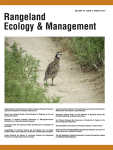Ver ítem
- xmlui.general.dspace_homeCentros Regionales y EEAsCentro Regional La Pampa - San LuisEEA San LuisArtículos científicosxmlui.ArtifactBrowser.ItemViewer.trail
- Inicio
- Centros Regionales y EEAs
- Centro Regional La Pampa - San Luis
- EEA San Luis
- Artículos científicos
- Ver ítem
Soil physical changes after conversion of woodlands to pastures in dry Chaco rangelands (Argentina)
Resumen
The conversion of dry woody rangelands into pastures can alter key soil physical properties that regulate ecosystem water circulation and storage. Based on three paired stands of native woodlands and pastures established 20 years ago in the southern Dry Chaco (San Luis, Argentina), we described contrasts in five soil physical properties using a systematic sampling of soil patches (9 − 18 patches along a single transect within each of the three paired 1-ha
[ver mas...]
The conversion of dry woody rangelands into pastures can alter key soil physical properties that regulate ecosystem water circulation and storage. Based on three paired stands of native woodlands and pastures established 20 years ago in the southern Dry Chaco (San Luis, Argentina), we described contrasts in five soil physical properties using a systematic sampling of soil patches (9 − 18 patches along a single transect within each of the three paired 1-ha stands). Compared with woodlands, pastures displayed flatter microtopography (mean ± standard deviation [SD]: 3.7 ± 0.34 vs. 5.0 ± 0.67% slope; P < 0.05), lower infiltration rate (mean ± SD: 71.6 ± 9.0 vs. 139.9 ± 37.2 mm h− 1; P < 0.05), and higher penetration resistance (mean ± SD: 4.2 ± 0.10 vs. 1.9 ± 0.17 kg cm− 2; P < 0.01) and bulk density (mean ± SD: 1.39 ± 0.05 vs. 1.16 ± 0.04 g cm− 3; P < 0.0001). On average, topsoil water content at field capacity was similar for both types of cover (mean ± SD: 16.3 ± 0.21 vs. 17.1 ± 1.12%, pastures and woodlands, respectively; P = 0.29). However, at similar bulk density values, pastures presented a ~ 20% reduction in volumetric water content at field capacity (16.3%) compared with woodlands (19.7%). The establishment of pastures led to more homogenous soils, with most variables having reduced spatial variability in comparison with woodlands. Our observations showed how the conversion of native woodlands to pastures produced strong physical changes in the soils of Dry Chaco and help to understand the mechanisms that are most likely influencing the surface-soil water dynamics of these, and perhaps other, dry rangelands.
[Cerrar]

Autor
Magliano, Patricio Nicolás;
Fernandez, Roberto J.;
Florio, Eva Laura;
Murray, Francisco;
Jobbagy Gampel, Esteban Gabriel;
Fuente
Rangeland ecology & management 70 (2) : 225-229. (March 2017)
Fecha
2017-03
ISSN
1550-7424
1551-5028
1551-5028
Formato
pdf
Tipo de documento
artículo
Palabras Claves
Derechos de acceso
Restringido
 Excepto donde se diga explicitamente, este item se publica bajo la siguiente descripción: Creative Commons Attribution-NonCommercial-ShareAlike 2.5 Unported (CC BY-NC-SA 2.5)
Excepto donde se diga explicitamente, este item se publica bajo la siguiente descripción: Creative Commons Attribution-NonCommercial-ShareAlike 2.5 Unported (CC BY-NC-SA 2.5)

